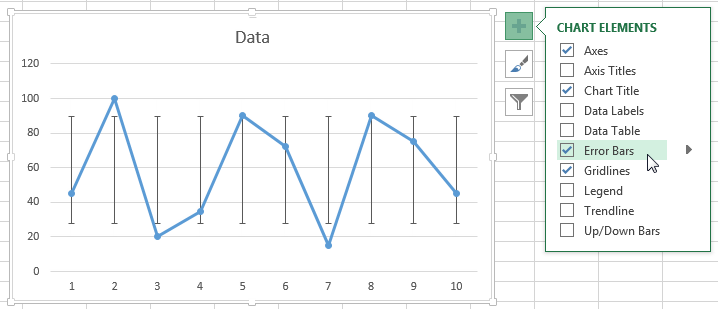

In Excel, the STDEV and STDEV.S calculate sample standard deviation while STDEVP and STDEV.P calculate population standard deviation. If you select the paint icon or the pentagon icon, you’ll see many other ways you can customize how error bars look in Excel.The standard deviation shows the variability of the data values from the mean (average).


This will open the Error Bar Options window. In the error bar dropdown box, select More Options at the bottom of the list. If you want to calculate the standard deviation yourself and display that value instead you can do that.

The actual calculation for standard deviation is somewhat complex and beyond the scope of this article. Standard Deviation: Excel calculates and displays the standard deviation (one value) for all values.Percentage: Excel calculates and displays the specific error percentage for each data point.Standard Error: Displays the standard error for each data point.You can choose from three pre configured error bar options in Excel. The pop-up box you see provides you with several options to configure the error amount that the error bars will display in the chart.īefore you can select one of the preconfigured options, it’s important to understand what each option means and how it works. To get started, click on the chart and then select the Chart Elements button (the + symbol) at the upper right corner of the chart.ģ. To add error bars in Excel, you need to start with an existing graph you’ve already created.ġ. Or, you can add error bars in Excel and let Excel do the calculations for you. You could calculate margin of error and standard deviation for yourself ( Excel even provides standard deviation functions). It tells you how much the data points are spread out around the overall average or mean of all data points. The standard deviation is a measure of how spread out your data is. Standard deviation is a component that’s used to calculate margin of error.The margin of error tells you how far the data from that sample could vary from the “real” result for the entire population. This is commonly used in statistics when the data is from a sample that makes up a larger population. Margin of error is the “uncertainty” of the data point.
HOW TO CALCULATE STANDARD ERROR IN EXCEL 2007 HOW TO
Margin of Error & Standard Deviationīefore you can learn how to add error bars in Excel, it’s important to understand what both margin of error and standard deviation are. Error bars are available in Excel for area, bar, column, line, scatter, and bubble charts.


 0 kommentar(er)
0 kommentar(er)
